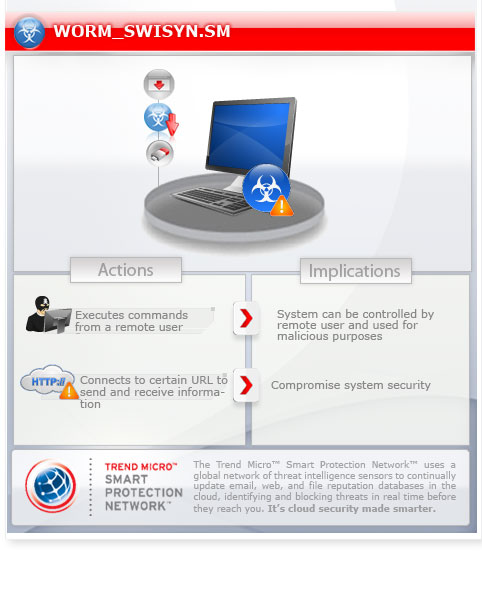WORM_SWISYN.SM
Mal/VB-GI (Sophos) ,Trojan horse Generic31.URJ (AVG) ,W32/Cospet.HA!tr (Fortinet) ,Trojan.Win32.Swisyn (Ikarus) ,Trojan-FakeAV.Win32.Windef.myj (Kaspersky) ,Worm:Win32/Ainslot.A (Microsoft) ,W32/Shadebot (McAfee) ,Win32/Ainslot.AB worm (Eset) ,W32.Shadesrat (Symantec) ,Trojan.Win32.Ainslot.b (v) (Sunbelt)
Windows 2000, Windows Server 2003, Windows XP (32-bit, 64-bit), Windows Vista (32-bit, 64-bit), Windows 7 (32-bit, 64-bit)


Threat Type: Worm
Destructiveness: No
Encrypted: No
In the wild: Yes
OVERVIEW
Via physical/removable drives, Downloaded from P2P shares
This malware is created by a toolkit known as Blackshades. The functions of this malware is similar to a RAT that can steal information, launch denial of service (DoS) attacks, and download malware among others.
To get a one-glance comprehensive view of the behavior of this Worm, refer to the Threat Diagram shown below.

This worm arrives via peer-to-peer (P2P) shares. It arrives via removable drives. It arrives on a system as a file dropped by other malware or as a file downloaded unknowingly by users when visiting malicious sites.
It executes commands from a remote malicious user, effectively compromising the affected system. It connects to a website to send and receive information.
TECHNICAL DETAILS
Varies
EXE
Yes
17 Mar 2011
Compromises system security, Launches DoS/DDoS attacks, Logs keystrokes, Connects to URLs/IPs
Arrival Details
This worm arrives via peer-to-peer (P2P) shares.
It arrives via removable drives.
It arrives on a system as a file dropped by other malware or as a file downloaded unknowingly by users when visiting malicious sites.
Autostart Technique
This worm adds the following registry entries to enable its automatic execution at every system startup:
HKEY_LOCAL_MACHINE\SOFTWARE\Microsoft\
Windows\CurrentVersion\Run
Windows = "%Application Data%\UCN14M5WQZ.exe"
HKEY_CURRENT_USER\Software\Microsoft\
Windows\CurrentVersion\Run
Windows = "%Application Data%\UCN14M5WQZ.exe"
HKEY_LOCAL_MACHINE\SOFTWARE\Microsoft\
Active Setup\Installed Components\DCC3BA6B-19AA-EDAC-BEFF-29CFBBE4CDEF}
StubPath = "%Application Data%\UCN14M5WQZ.exe"
Other System Modifications
This worm adds the following registry keys:
HKEY_CURRENT_USER\Software\VB and VBA Program Settings\
SrvID\ID
HKEY_CURRENT_USER\Software\VB and VBA Program Settings\
INSTALL\DATE
HKEY_LOCAL_MACHINE\SOFTWARE\Microsoft\
Active Setup\Installed Components\DCC3BA6B-19AA-EDAC-BEFF-29CFBBE4CDEF}
It adds the following registry entries:
HKEY_CURRENT_USER\Software\VB and VBA Program Settings\
SrvID\ID
VWEBQMMOPT = "ottsy's Bot"
HKEY_CURRENT_USER\Software\VB and VBA Program Settings\
INSTALL\DATE
VWEBQMMOPT = "{Date}"
Backdoor Routine
This worm executes the following commands from a remote malicious user:
- View webcam
- Download and execute arbitrary files
- Perform distributed denial-of-service (DDoS) attacks
- Grab passwords
- Monitor Windows titles
- Log keystrokes
- Propagate via USBs and instant messaging (IM)
- Load additional plugins
- Visit URLs
It connects to the following websites to send and receive information:
- {BLOCKED}ay.{BLOCKED}p.org:53
- {number}{BLOCKED}way.{BLOCKED}p.org:53
SOLUTION
9.700
7.908.14
17 Mar 2011
7.909.00
18 Mar 2011
Step 1
Before doing any scans, Windows XP, Windows Vista, and Windows 7 users must disable System Restore to allow full scanning of their computers.
Step 2
Restart in Safe Mode
Step 3
Delete this registry key
Important: Editing the Windows Registry incorrectly can lead to irreversible system malfunction. Please do this step only if you know how or you can ask assistance from your system administrator. Else, check this Microsoft article first before modifying your computer's registry.
- In HKEY_CURRENT_USER\Software\VB and VBA Program Settings\SrvID
- ID
- ID
- In HKEY_CURRENT_USER\Software\VB and VBA Program Settings\INSTALL
- DATE
- DATE
- In HKEY_LOCAL_MACHINE\SOFTWARE\Microsoft\Active Setup\Installed Components
- DCC3BA6B-19AA-EDAC-BEFF-29CFBBE4CDEF}
- DCC3BA6B-19AA-EDAC-BEFF-29CFBBE4CDEF}
Step 4
Delete this registry value
Important: Editing the Windows Registry incorrectly can lead to irreversible system malfunction. Please do this step only if you know how or you can ask assistance from your system administrator. Else, check this Microsoft article first before modifying your computer's registry.
- In HKEY_CURRENT_USER\Software\Microsoft\Windows\CurrentVersion\Run
- Windows = "%Application Data%\UCN14M5WQZ.exe"
- Windows = "%Application Data%\UCN14M5WQZ.exe"
- In HKEY_LOCAL_MACHINE\SOFTWARE\Microsoft\Active Setup\Installed Components\DCC3BA6B-19AA-EDAC-BEFF-29CFBBE4CDEF}
- StubPath = "%Application Data%\UCN14M5WQZ.exe"
- StubPath = "%Application Data%\UCN14M5WQZ.exe"
Step 5
Restart in normal mode and scan your computer with your Trend Micro product for files detected as WORM_SWISYN.SM. If the detected files have already been cleaned, deleted, or quarantined by your Trend Micro product, no further step is required. You may opt to simply delete the quarantined files. Please check this Knowledge Base page for more information.
Did this description help? Tell us how we did.


